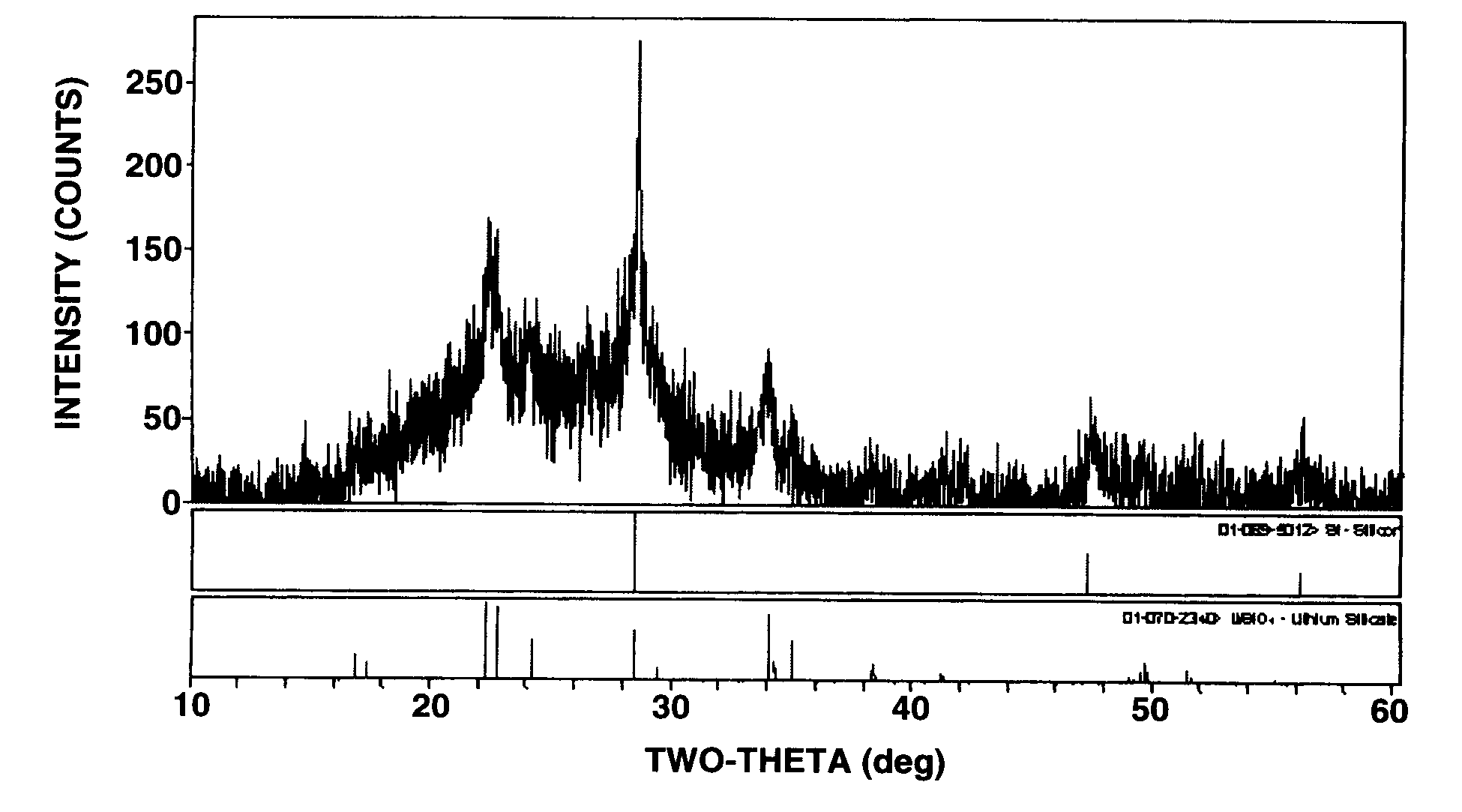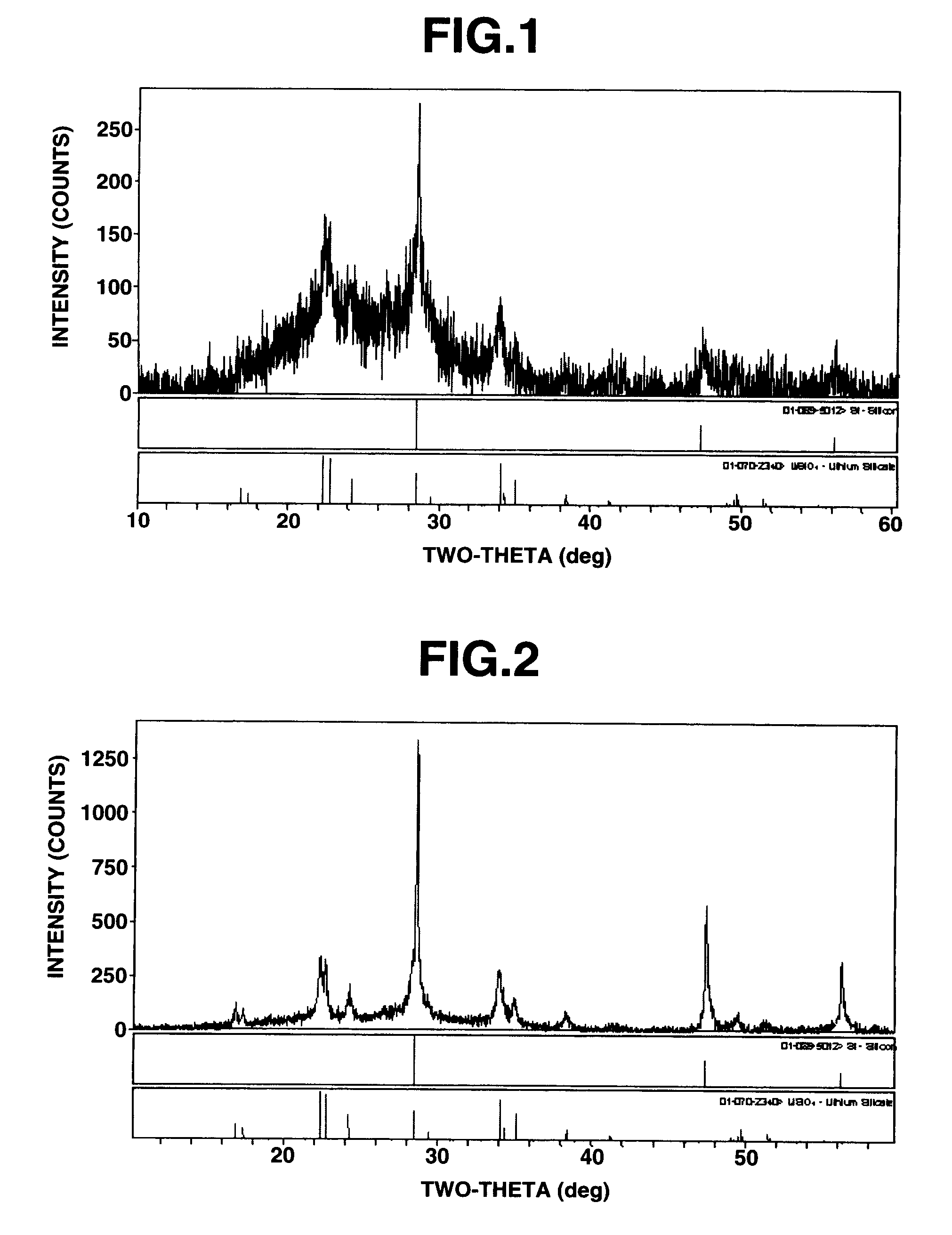Silicon-silicon oxide-lithium composite, making method, and non-aqueous electrolyte secondary cell negative electrode material
a technology of silicon oxide and composite, which is applied in the direction of silicates, silicon compounds, cell components, etc., can solve the problems of insufficient cycle performance, failure to fully meet the characteristics required in the market, and not necessarily satisfactory, so as to achieve high initial efficiency and improve cycle performance
- Summary
- Abstract
- Description
- Claims
- Application Information
AI Technical Summary
Benefits of technology
Problems solved by technology
Method used
Image
Examples
reference example 1
[0051]The structure of a conductive silicon composite prepared according to the invention is described by referring to an exemplary silicon-silicon oxide-lithium composite obtained from silicon oxide (SiOx).
[0052]Silicon oxide (SiOx, x=1.02) was milled in a ball mill, using hexane as a dispersing medium, to an average particle size of 5 μm. In a globe box under an argon blanket, a portion (8.7 g) of the silicon oxide powder was weighed and placed in a 50-g glass vial. Stabilized lithium powder SLMP (FMC Corp.), 1.3 g, was added to the vial, which was closed with a cap and manually shaken for mixing. The mixture was transferred to a 500-ml stainless steel jar of a planetary ball mill PM-100 (Retsch GmbH), containing ten stainless steel balls of each 32 g. The jar was closed, taken out of the globe box, and mounted in place on the planetary ball mill PM-100. The jar was rotated at a rotational speed of 500 rpm in forward and backward directions each for 10 minutes while maintaining an...
example 1
[0054]Silicon oxide (SiOx, x=1.02) was milled in a ball mill, using hexane as a dispersing medium, to an average particle size of 5 μm. In a globe box under an argon blanket, a portion (8.7 g) of the silicon oxide powder was weighed and placed in a glass vial with an internal volume of about 50 ml. Stabilized lithium powder SLMP (FMC Corp.), 1.3 g, was added to the vial, which was closed with a cap and manually shaken for mixing. The mixture was transferred to a 500-ml stainless steel jar of a planetary ball mill PM-100 (Retsch GmbH), containing ten stainless steel balls of each 32 g. The jar was closed, taken out of the globe box, and mounted in place on the planetary ball mill PM-100. The jar was rotated at a rotational speed of 500 rpm in forward and backward directions each for 10 minutes. The jar was allowed to cool, after which the silicon-silicon oxide-lithium composite was taken out. It was analyzed by X-ray diffractometry. Silicon crystallites ((111) face) had a size of 50 ...
example 2
[0061]Silicon oxide (SiOx, x=1.02) was milled in a ball mill, using hexane as a dispersing medium, to an average particle size of 5 μm. In a globe box under an argon blanket, a portion (8.7 g) of the silicon oxide powder was weighed and placed in a glass vial with an internal volume of about 50 ml. Stabilized lithium powder SLMP (FMC Corp.), 1.0 g, was added to the vial, which was closed with a cap and manually shaken for mixing. The mixture was transferred to a 500-ml stainless steel jar of a planetary ball mill PM-100 (Retsch GmbH), containing ten stainless steel balls of each 32 g. The jar was closed, taken out of the globe box, and mounted in place on the planetary ball mill PM-100. The jar was rotated at a rotational speed of 500 rpm in forward and backward directions each for 10 minutes. The jar was allowed to cool, after which the silicon-silicon oxide-lithium composite was taken out. It was analyzed by X-ray diffractometry. Silicon crystallites ((111) face) had a size of 40 ...
PUM
| Property | Measurement | Unit |
|---|---|---|
| size | aaaaa | aaaaa |
| temperature | aaaaa | aaaaa |
| temperature | aaaaa | aaaaa |
Abstract
Description
Claims
Application Information
 Login to View More
Login to View More - R&D
- Intellectual Property
- Life Sciences
- Materials
- Tech Scout
- Unparalleled Data Quality
- Higher Quality Content
- 60% Fewer Hallucinations
Browse by: Latest US Patents, China's latest patents, Technical Efficacy Thesaurus, Application Domain, Technology Topic, Popular Technical Reports.
© 2025 PatSnap. All rights reserved.Legal|Privacy policy|Modern Slavery Act Transparency Statement|Sitemap|About US| Contact US: help@patsnap.com


